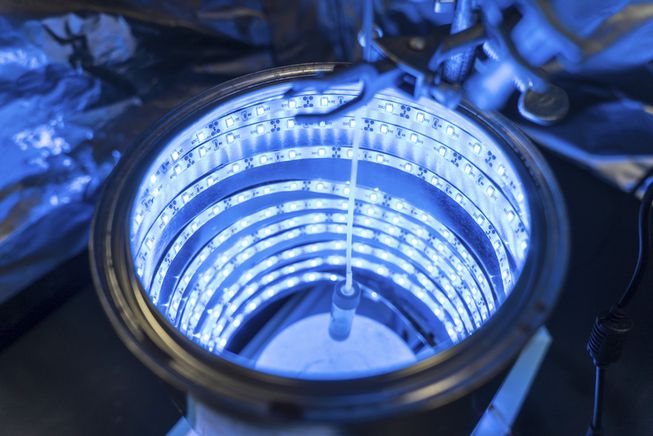Source: mnn.com
Published: April 27, 2017

Device works in a similar way to how plants convert carbon dioxide and sunlight into food (Photo: Bernard Wilchusky/UCF)
By Bryan Nelson
University of Central Florida chemistry professor Fernando Uribe-Romo has finally achieved what scientists around the world have been attempting for years: a device that triggers artificial photosynthesis in a synthetic material, reports Phys.org.
Just as plants are capable of making food from sunlight and carbon dioxide, Uribe-Romo’s invention scrubs the air of greenhouse gases and produces fuel. It’s not the first time artificial photosynthesis has been achieved, but it’s the first time it has been done with a cost-effective synthetic material, making the technology viable.
“This work is a breakthrough,” said Uribe-Romo, deservedly touting his invention. “Tailoring materials that will absorb a specific color of light is very difficult from the scientific point of view, but from the societal point of view we are contributing to the development of a technology that can help reduce greenhouse gases.”
One of the major hold-ups that other scientists have encountered while trying to make similar devices has been getting visible light to trigger the chemical transformation. Ultraviolet light can do the trick easily enough because of its higher energy level, but UVs make up only about 4 percent of the light Earth receives from the sun. To make the technology truly viable, the process must be triggered by visible light.
There are some very rare materials that can do the trick with visible light, such as platinum, rhenium and iridium, but because these materials are so rare, the price tag on building a device with them is highly deterring. However, Uribe-Romo pulled it off with titanium — a common and nontoxic metal — by adding light harvesting antenna molecules, called N-alkyl-2-aminoterephthalates, that can be designed to absorb specific colors of light. For the prototype, the molecules were synchronized for the color blue.
To test it, Uribe-Romo and his team fed carbon dioxide to a blue LED photoreactor. Sure enough, a chemical reaction transformed the carbon dioxide into two reduced forms of carbon, formate and formamides, which happen to be two kinds of solar fuel.
It all seems too good to be true. A device that scrubs the air of excess carbon dioxide while producing energy? Uribe-Romo already has his sales pitch ready:
“The idea would be to set up stations that capture large amounts of CO2, like next to a power plant. The gas would be sucked into the station, go through the process and recycle the greenhouse gases while producing energy that would be put back into the power plant.”
Regular consumers could potentially use this technology, too. Imagine houses lined with rooftop shingles made of the material, which suck carbon dioxide from the air while effortlessly supplying power to the homes.
“That would take new technology and infrastructure to happen,” Uribe-Romo said. “But it may be possible.”
The work was published in the Journal of Materials Chemistry A.
